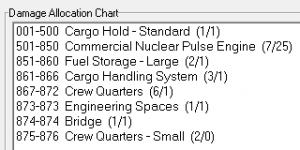Aurora is on version 2.5.0 C#, available at the Aurora Forums.
Contact Erik on the forum for a wiki account.
Internal Damage
Internal Damage occurs when incoming damage is not blocked by a ship's shields or armor. This can occur if the shields and armor are penetrated, or more directly via
attacks. When internal damage is inflicted, it is distributed according to the ship's Damage Allocation Chart.
Damage Allocation
A ship's Damage Allocation Chart is visible in the Class Design window for that ship under the DAC/Rank/Info tab. It contains a listing of numeric ranges next to the ship's individual components, which represent their notional location underneath the ship's armor grid. When a hit is inflicted in those locations, damage is applied to the internal components at that area of the chart.
When a component receives damage, that damage is weighed against its HTK value. The chance of destroying a component is calculated by:
Incoming Damage / Component HTK
If the component survives the roll, the damage is expended uselessly and the component remains intact. If the component fails the roll, however, the component will be destroyed. If the damage inflicted on the component meets or exceeds the HTK of that component, destruction is guaranteed. Damage in excess of the HTK is carried forward (less the destroyed component's HTK) to other components. If damage to a given type of component is attempted and no intact components of that type are found, the damage is reallocated to another point in the chart.
Damage that attempts to reallocate 20 times without finding intact components to apply to will destroy the ship. Any components which are still intact upon ship destruction may be found via salvaging the resulting wreck.
Secondary Explosions
Components which are destroyed (in particular Power Plants and Magazines) may explode for further secondary damage. Damage of this type can be highly destructive for an already-damaged ship, especially if it causes further explosions from other destroyed systems. Researching technology for magazine ejection and avoiding reactor power boosts can reduce the risk of this happening.
High-Powered Microwaves
A special Damage Allocation Chart exists for High-Powered Microwaves containing only those electronic systems the microwave can damage, including sensors, fire control systems, ECM and ECCM. The behavior of this chart is similar to the standard chart described above, although there is no chance of ship destruction due to microwave assault.
